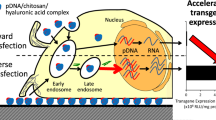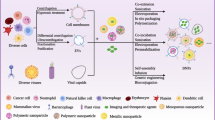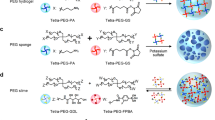Abstract
In vivo gene transfer with recombinant adenovirus vectors can be hindered by the immunogenicity of the adenovirus capsid proteins. Previous work showed that formulation of the vector with biodegradable polymers such as poly-lactic-glycolic acid (PLGA), polyethylene glycol (PEG), or lipids, may shield the virus from inhibition by neutralizing antibodies. Formulation of adenovirus in PLGA microspheres also allowed for extended release in vitro. In experiments described here, we found that the surfactant used in the formation of the primary emulsion could significantly improve the overall yield of virus released. We also tested the effects of adding poly-L-lysine to adenovirus before encapsulation with PLGA. Our results show that although PLL did not effect the yield of virus encapsulated or released from the microspheres, it significantly improved the efficiency of gene transfer after release from the polymer.
This is a preview of subscription content, access via your institution
Access options
Subscribe to this journal
Receive 12 print issues and online access
$259.00 per year
only $21.58 per issue
Buy this article
- Purchase on Springer Link
- Instant access to full article PDF
Prices may be subject to local taxes which are calculated during checkout









Similar content being viewed by others
References
Crystal RG et al. Administration of an adenovirus containing the human CFTR cDNA to the respiratory tract of individuals with cystic fibrosis Nat Genet 1994 8: 42–51
Zabner J et al. Safety and efficacy of repetitive adenovirus-mediated transfer of CFTR cDNA to airway epithelia of primates and cotton rats Nat Genet 1994 6: 75–83
Knowles MR et al. A controlled study of adenoviral-vector-mediated gene transfer in the nasal epithelium of patients with cystic fibrosis New Engl J Med 1995 333: 823–831
Eck SL et al. Treatment of advanced CNS malignancies with the recombinant adenovirus H5.010RSVTK: a phase I trial Hum Gene Ther 1996 7: 1465–1482
Gahery-Segard H et al. Phase I trial of recombinant adenovirus gene transfer in lung cancer. Longitudinal study of the immune responses to transgene and viral products J Clin Invest 1997 100: 2218–2226
Puumalainen AM et al. Beta-galactosidase gene transfer to human malignant glioma in vivo using replication-deficient retroviruses and adenoviruses Hum Gene Ther 1998 9: 1769–1774
Lieber A, He CY, Kirillova I, Kay MA . Recombinant adenoviruses with large deletions generated by Cre-mediated excision exhibit different biological properties compared with first-generation vectors in vitro and in vivo J Virol 1996 70: 8944–8960
Mitani K, Graham FL, Caskey CT, Kochanek S . Rescue, propagation, and partial purification of a helper virus-dependent adenovirus vector Proc Natl Acad Sci USA 1995 92: 3854–3858
Morsy MA et al. An adenoviral vector deleted for all viral coding sequences results in enhanced safety and extended expression of a leptin transgene Proc Natl Acad Sci USA 1998 95: 7866–7871
Schiedner G et al. Genomic DNA transfer with a high-capacity adenovirus vector results in improved in vivo gene expression and decreased toxicity Nat Genet 1998 18: 180–183
Horwitz MS . Adenoviridae and their replication. In: Fields BN, Knipe DM (eds) Fundamental Virology Raven Press: New York 1991 771–813
Yang Y, Greenough K, Wilson JM . Transient immune blockade prevents formation of neutralizing antibody to recombinant adenovirus and allows repeated gene transfer to mouse liver Gene Therapy 1996 3: 412–420
Scaria A et al. Antibody to CD40 ligand inhibits both humoral and cellular immune responses to adenoviral vectors and facilitates repeated administration to mouse airway Gene Therapy 1997 4: 611–617
Stein CS Pemberton JL, van Rooijen N, Davidson BI . Effects of macrophage depletion and anti-CD40 ligand on transgene expression and redosing with recombinant adenovirus Gene Therapy 1998 5: 431–439
Wilson CB et al. Transient inhibition of CD28 and CD40 ligand interactions prolongs adenovirus-mediated transgene expression in the lung and facilitates expression after secondary vector administration J Virol 1998 72: 7542–7550
Beer SJ et al. Poly (lactic-glycolic) acid co-polymer encapsulation of recombinant adenovirus reduces immunogenicity in vivo Gene Therapy 1998 5: 740–746
Chillon M Lee JH, Fasbender A, Welsh MJ . Adenovirus complexed with polyethylene glycol and cationic lipid is shielded from neutralizing antibodies in vitro Gene Therapy 1998 5: 995–1002
Gall J, Kass-Eisler A, Leinwand L, Falck-Pedersen E . Adenovirus type 5 and 7 capsid chimera: fiber replacement alters receptor tropism without affecting primary immune neutralization epitopes J Virol 1996 70: 2116–2123
Cleland JL . Protein delivery from biodegradable microspheres Pharm Biotechnol 1997 10: 1–43
Cohen S et al. Controlled delivery systems for proteins based on poly(lactic/glycolic acid) microspheres Pharm Res 1991 8: 713–720
Gref R et al. Biodegradable long-circulating polymeric nanospheres Science 1994 263: 1600–1603
Cleland JL et al. The stability of recombinant human growth hormone in poly(lactic-co-glycolic acid) (PLGA) microspheres Pharm Res 1997 14: 420–425
Mathiowitz E et al. Biologically erodable microspheres as potential oral drug delivery systems Nature 1997 386: 410–414
Igartua M et al. Influence of formulation variables on the in vitro release of albumin from biodegradable microparticulate systems J Microencapsul 1997 14: 349–356
Tabata Y, Gutta S, Langer R . Controlled delivery systems for proteins using polyanhydride microspheres Pharm Res 1993 10: 487–496
Coombes AG, Yeh MK, Lavelle EC, Davis SS . The control of protein release from poly(DL-lactide co-glycolide) microparticles by variation of the external aqueous phase surfactant in the water-in oil-in water method J Control Rel 1998 52: 311–320
Zografi G . Interfacial phenomena. In: Osol A (ed) Remington’s Pharmaceutical Sciences Mack Publishing: Easton, PA 1975 285–298
Nihant N et al. Polylactide microparticles prepared by double emulsion/evaporation technique. I. Effect of primary emulsion stability Pharm Res 1994 11: 1479–1484
Johnson OL et al. The stabilization and encapsulation of human growth hormone into biodegradable microspheres Pharm Res 1997 14: 730–735
Wang YM, Sato H, Adachi I, Horikoshi I . Preparation and characterization of poly(lactic-co-glycolic acid) microspheres for targeted delivery of a novel anticancer agent, taxol Chem Pharm Bull 1996 44: 1935–1940
Fasbender A et al. Complexes of adenovirus with polycationic polymers and cationic lipids increase the efficiency of gene transfer in vitro and in vivo J Biol Chem 1997 272: 6479–6489
Graham FL, van der Eb AJ . A new technique for the assay of infectivity of human adenovirus 5 DNA Virology 1973 52: 456–467
Lemarchand P et al. Adenovirus-mediated transfer of a recombinant human alpha 1-antitrypsin cDNA to human endothelial cells Proc Natl Acad Sci USA 1992 89: 6482–6486
Pekarek KJ, Jacob JS, Mathiowitz E . Double-walled polymer microspheres for controlled drug release Nature 1994 367: 258–260
Acknowledgements
The authors would like to thank the University of Iowa Gene Transfer Vector Core supported, in part, by the Carver Foundation. This work was supported in part by the NIH (R43-CA67357). CBM is the recipient of a predoctoral fellowship from the Iowa Affiliate, American Heart Foundation.
Author information
Authors and Affiliations
Rights and permissions
About this article
Cite this article
Matthews, C., Jenkins, G., Hilfinger, J. et al. Poly-L-lysine improves gene transfer with adenovirus formulated in PLGA microspheres. Gene Ther 6, 1558–1564 (1999). https://doi.org/10.1038/sj.gt.3300978
Received:
Accepted:
Published:
Issue Date:
DOI: https://doi.org/10.1038/sj.gt.3300978
Keywords
This article is cited by
-
A cost-effective method to enhance adenoviral transduction of primary murine osteoblasts and bone marrow stromal cells
Bone Research (2016)
-
Tailoring minimalist self-assembling peptides for localized viral vector gene delivery
Nano Research (2016)
-
Bioactive baculovirus nanohybrids for stent based rapid vascular re-endothelialization
Scientific Reports (2013)
-
Engineering Biomaterial Systems to Enhance Viral Vector Gene Delivery
Molecular Therapy (2011)
-
Carrier Cell-based Delivery of an Oncolytic Virus Circumvents Antiviral Immunity
Molecular Therapy (2007)



